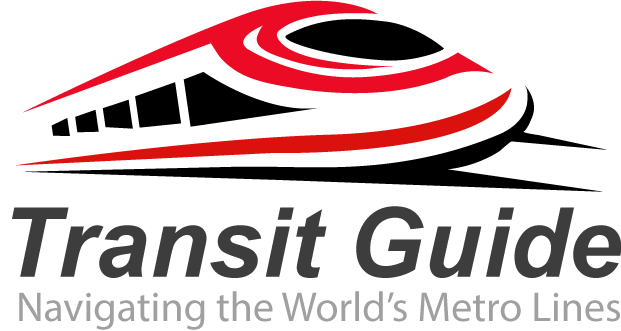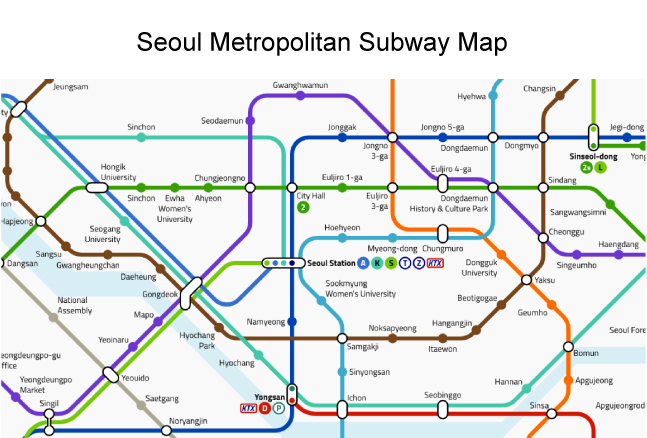The Seoul Metropolitan Subway is one of the most extensive and advanced urban rail systems in the world. It covers the Seoul Capital Area, including Seoul, Incheon, and the Gyeonggi Province, serving as a backbone for daily commuting and transportation needs.
Lines and Coverage
- Total Lines: 23
- Total Stations: Over 700
- Total Length: Approximately 1,150 kilometers
Key Lines:
- Line 1: Connects the northern and southern parts of the city, including Seoul Station and Dongdaemun.
- Line 2: The circular line, one of the busiest, connecting major areas such as Gangnam, Hongdae, and Jamsil.
- Line 4: Connects the southern and northern regions, including Sadang and Dongdaemun History & Culture Park.
Key Features
- Connectivity: Seamless integration with buses, regional trains, and high-speed rail services.
- Accessibility: Elevators, escalators, and barrier-free facilities in all stations for the elderly and disabled.
- Technology: Real-time tracking, Wi-Fi, and mobile charging stations available on most lines.
- Safety: Equipped with CCTV, platform screen doors, and emergency response systems.
Ticketing and Fare
- T-money Card: A rechargeable smart card used for fare payments on the subway, buses, taxis, and at convenience stores.
- Single Journey Tickets: Available for tourists and infrequent travelers.
- Fare Calculation: Based on distance traveled, starting at around 1,250 KRW (approximately $1.10 USD) for up to 10 km, with incremental increases for longer distances.
Popular Tourist Routes
- Historic and Cultural Sites:
- Gyeongbokgung Palace: Gyeongbokgung Station (Line 3)
- Bukchon Hanok Village: Anguk Station (Line 3)
- Insadong: Jongno 3-ga Station (Lines 1, 3, 5)
- Shopping and Entertainment:
- Myeongdong: Myeongdong Station (Line 4)
- Dongdaemun Design Plaza: Dongdaemun History & Culture Park Station (Lines 2, 4, 5)
- COEX Mall: Samseong Station (Line 2)
- Natural Attractions:
- Namsan Seoul Tower: Myeongdong Station (Line 4) + Cable Car
- Bukhansan National Park: Gupabal Station (Line 3)
- Hangang River Parks: Various stations along Line 5 and Line 7
Future Developments
- Line Extensions: Several lines are being extended to improve connectivity to suburban areas.
- New Lines: Plans for additional lines to further expand the network and reduce congestion.
- Technological Upgrades: Implementation of more AI-based solutions for efficient train management and passenger information.
Cultural Insights
- Subway Culture: The Seoul Subway is known for its quiet and orderly atmosphere. Passengers are often seen reading, using smartphones, or napping during their commute.
- Public Art: Many stations feature unique public art installations, murals, and sculptures, making each station a mini cultural exhibit.
- Etiquette: Priority seats are reserved for the elderly, pregnant women, and those with disabilities. It’s customary to give up your seat to those in need.
Tips for Tourists
- Download Subway Apps: Apps like “Subway Korea” and “KakaoMetro” provide real-time updates, route planning, and maps in English.
- Rush Hours: Avoid traveling during peak hours (7:00-9:00 AM and 6:00-8:00 PM) for a more comfortable experience.
- Emergency Procedures: Familiarize yourself with emergency exits and procedures, indicated in English throughout the stations.
Seoul Metropolitan Subway Map
You can find the latest map of the Seoul Metropolitan Subway from various official and tourism resources. The official Seoul Metro website provides an up-to-date and interactive map. Here is a simplified version for quick reference:
For a detailed, interactive map, you can visit the Seoul Metro Map
Contact Information Seoul Metro
- Customer Service Center: +82-2-1577-1234
- Address: 346, Cheonggyecheon-ro, Jongno-gu, Seoul, Korea
For more details please visit its website. Explore additional metro lines across Asia

